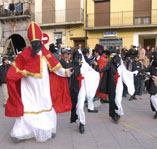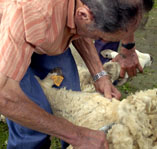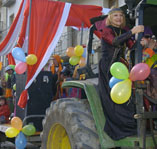









|
The Carnival of Sort is the celebration that starts the year festivities and everybody is expecting its arrival. Tuesday in Carnival is a local holiday and corresponds to the day before Ash Wednesday. The fact that still during Franco’s dictatorship the people of Sort keep celebrating it, dressing up and covering their faces even ignoring the warnings of the authorities, have turned this celebration into a symbol and a tradition enjoyed by young and older. The activities and events take part from Saturday to Tuesday: arrival of king Requincuà, opening speech by the Carnival Mayor, fancy dress ball, collecting food for the Calderada, parading and dancing, popular Calderada (lunch), Farcit de Carnaval contest (typical cold meat from Sort), Burial of the Sardine...
Sheep shearing with scissors, onSant Joan’s day (24 June), in Parc del Riuet. It is a new way to make this ancient trade better known to people. The Valley of Àssua and the Bailiwick of Sort are both shepherding lands and onSant Joan’s day, the activities related to its traditions are brought back. There is also a fair with artisan products.
International Rally La Noguera Pallaresa, a celebration considered A National Cultural Heritage that had its first edition in 1964. Since then, year after year, it has been held during the month of July. It lasts for a week and there are all kinds of activities related to the river: kayaking and canoeing competitions, popular descents, night rafting competition, popular arrossada (rice dish), gold quest, film projections...
Village Festivals. The town festival in Sort takes place around 1 August. Since it is the celebration of the patron saint’s day, Sant Feliu, it is also the starting signal for the endless celebrations in each one of the villages in the municipality, one after the other during the months of August, September, October, finishing with the one in Montardit de Dalt, on 22 November.
The time of the town festival of Sort is one of the few occasions when the dance of the Rigodons can be seen as well as the town’s gegants (giants), the count Arnau Roger and Princess Làscaris.
Open Night Tourist Chess, a leisure and sports activity for all ages held around 15 August.
Siege of Olp, theatrerepresentation of the chapter when the people of Olp resisted the siege during the War of El Pallars (1484-1487) and the resistance of the castle in València d’Àneu by Caterina Albert, wife of the last Catalan count, Hug Roger III.
On August 15, the little village of Olp is turned into a medieval hamlet for a few hours, honouring the struggle of their ancestors in the 15th century against the invading royal troops.
Homage to General Moragues
Josep Moragues i Mas was a Catalan military man who fought on the side of Charles of Austria and became a battle General against the army of Philip V. The victory of Philip against those in favour of the House of Austria meant the establishment of the House of Bourbon in Spain and the end of the rights and privileges of the Crown of Aragon.
He was a true hero, still courageous in the Catalan defeat on 11 September 1714.
Thanks to his second marriage to Magdalena Giralt, who was born in Sort, the town was made his late home, where he lived many years. At the end of his life, he was arrested, tortured and beheaded in Barcelona.
On 11 September, Sort pays homage to this unknown hero with an offering of flowers at the foot of his monuments and then, a series of events with the collaboration of entities and associations.
Fair of Llessui
There is a show of ancient trades and grafts, products of the Valley of Àssua, a taste of violin and accordion, an exhibition of the Catalan donkey breed and a ride on a cart.
There are also workshops to learn how to make soap and bread, storytelling and workshops for children.
Autumn Fair. Exhibition of Xisqueta Sheep Breed
It is a multisectoral fair where the visitor will be able to see and evaluate many things, from farm and agricultural machinery and cars to an artisan market with product tastings.
It also takes place the singular exhibition of Xisqueta sheep breed. It is a very old sheep breed, which has developed very little, so it has kept a high degree of purity, thanks to its geographical isolation. It is native from Catalonia, but today some herds can be found in the neighbouring province of Aragon. It is a rustic race, with a very resistant frame and very active one, too; its reproduction fitness is very good. |